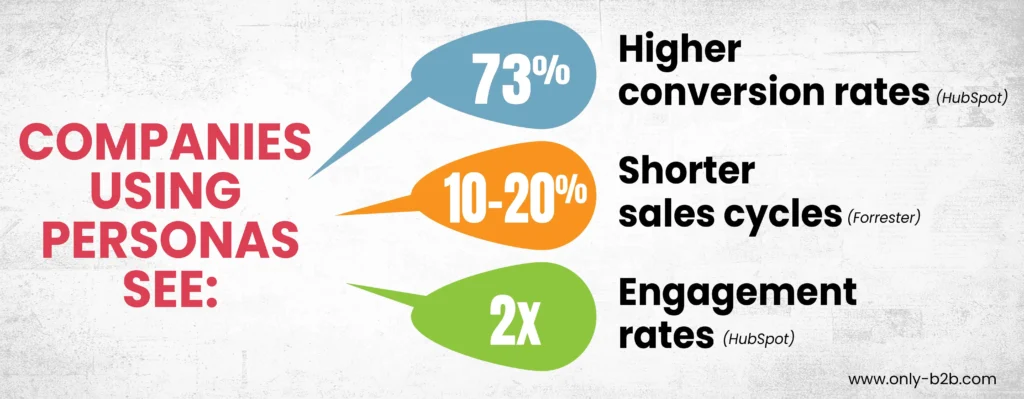Is the buyer persona dead or simply misunderstood?
You say buyer persona is losing importance in the age where intent data, account-based marketing, and AI promise laser-sharp targeting.
Surely technology tells us who’s showing buying signals, but it doesn’t explain why they are in the market, what challenges drive their urgency, or how their internal decisions are being shaped. And without that context, you are at high risk of wasted spend.

However, personas gather dust when they are built on assumptions, disconnected from real buyer insights, or treated as one-off projects.
When they are data-driven, iterative, and tied to business goals, they become a marketer’s secret weapon. If you are a B2B marketer, sales leader, or demand generation specialist, and feel you are wasting spend on irrelevant targeting, this blog is for you. Let’s dive in.
1. What is a B2B Buyer Persona?
Table of Contents
A B2B buyer persona is a research-driven representation of your target customer. Unlike B2C personas, which often focus on demographics like age, hobbies, or lifestyle, B2B personas focus on:
- Job roles and responsibilities
- Company size, industry, and revenue
- Goals and KPIs
- Pain points and challenges
- Buying triggers and objections
Example:
Instead of “Marketer Mary, a 35-year-old marketing manager who loves Instagram,” a B2B persona would look like:
“IT Director Ian: Works at a mid-market SaaS company with 200–500 employees. His key challenge is integrating multiple cloud tools securely. He measures success through cost savings and system uptime. Biggest objection: Long implementation times.”
Why Buyer Personas Matter for Demand Gen
We all have been there:
- Leads that look good on paper but do not convert
- Campaigns that generate clicks but no pipeline
- Sales teams wasting cycles on the wrong contacts
These problems are not new. They stem from relying too heavily on intent signals, firmographics, and demographics, which do not tell the full story.
For instance, a CMO at a SaaS firm and a CMO at a manufacturing company may both fit your ICP on paper, but their needs, challenges, and buying triggers are worlds apart.” Without personas, your campaigns treat them the same.
So how do personas solve this? They add context to whatever you do. They help you understand the buying committee, anticipate objections, and align messaging with actual decision drivers.
Step-by-Step: How to Create a B2B Buyer Persona
Step 1: Anchor to business objectives and ICP
Define your commercial objective, For example: “Increase qualified demo requests in North America for mid-market SaaS.
Then tie this to a clear ICP slice (industry, employee band, region). Note who will use the persona (demand gen, SDRs, AEs, content, product) so you build only what downstream teams will actually apply.
Step 2: Collect Buyer Data Across the Funnel
Pull what you already have: CRM/opportunity fields, MAP engagement, web analytics paths, and campaign tags.
Top- funnel: use CRM and web analytics to see which industries and roles engage most.
Mid-funnel: look at intent data from platforms like Bombora or G2.
Bottom of the funnel: use lost-deal analysis and sales call reviews to uncover objections and blockers.
Layer qualitative data over quantitative data. Quantitative data shows the patterns, qualitative conversations explain why. And that is how you build the complete picture.
Step 3: Map the Buying Committee
If you’re running ABM, you already think in terms of multiple roles within an account.
Personas make that tangible. How? Instead of saying “decision maker,” you’ll know that for a SaaS IT solution, the CIO approves the budget, the VP of IT leads the evaluation, the security manager influences requirements, and procurement signs off on compliance.
Does that feel like extra work? It is not. You are already mapping these roles when you design ABM campaigns or when sales tracks stakeholders in the CRM.
You just need to formalize them as personas. This way, you make the process consistent, repeatable, and shareable across teams.
Step 4: Define What Actually Moves Deals Forward
The pain of collecting irrelevant data points is real. The same applies to personas. Forget about vanity details like hobbies or favorite apps.
What’s important is to know what moves a deal forward or stalls it. It should align with business goals, decision triggers, objections, and the preferred buying process.
Now map these insights across the funnel. Pain points sit at the top of the funnel for content themes. Decision triggers and goals are useful in the middle-of-funnel offers. Objections prepare sales for bottom-of-funnel conversations.
Overall, defining personas will do no good unless you design them to slot into the funnel you already use.
Step 5: Build Personas That Feel Real
Drafting a persona is not a character sketch. It is building a sales playbook.
Take a VP of IT at a mid-market SaaS firm, call him SaaS Steve. His goals: cutting costs, ensuring reliability, and enabling secure remote work.
His challenges: legacy systems and cybersecurity threats.
His triggers: a recent breach or a board directive.
His objections: integration and ROI.
This isn’t a description. It’s sales intelligence.
It tells your SDRs how to open a conversation, your content team what assets to produce, and your ABM team how to frame campaigns.
Furthermore, adding quotes from interviews, such as “We need solutions that integrate, not another platform that sits in a silo,” brings him to life.
Step 6: Keep Personas Alive with Campaign Data
Personas shouldn’t be treated as an annual budget, just like demand gen campaigns.
Treat personas the way you treat A/B testing. Launch campaigns built on your persona, review performance, and refine.
If messaging falls flat, update the persona. If sales start hearing new objections, add them in.
Creating personas isn’t the challenge; keeping them alive is. Quarterly updates keep them aligned with market shifts.

Everything B2B Marketers Ask About Buyer Personas
Are buyer personas still relevant with ABM and intent data?
Yes, but in a smarter way. Intent data shows who is active; personas explain why they buy and how to approach them. ABM without personas is just blind targeting.
How many personas should we have?
Stick to two to four core personas. More than that dilutes your messaging. If your product is broad, start with one vertical or use case, then expand.
What is the best way to collect persona data?
Blend hard data and human insight. Use CRM and analytics for patterns, interview a handful of customers, review closed-lost deals, and monitor LinkedIn or review sites for authentic buyer language.
What mistakes should we avoid?
Do not make personas static. Avoid irrelevant trivia, do not ignore buying committees, and update them regularly with sales and campaign feedback.
Should personas include psychographics or just firmographics?
Both. Firmographics guide targeting (industry, role, size). Psychographics fuel messaging (pain points, motivators, risk tolerance). Leave out either, and you miss half the picture.
How do personas connect to lead qualification?
Personas refine your ICP and scoring models. They help answer: Is this the right role? Right industry? Showing the right signals? The closer the match, the sharper your targeting and the better your pipeline quality.
Conclusion: Making Personas Your Demand Gen Edge
Buyer personas give structure and context to your ICP and funnel. It’s more about addressing the challenges: misaligned campaigns, wasted budget, and irrelevant leads they have been facing for ages.
Don’t treat it as a side project. In reality, when personas are tied to business goals, mapped to buying committees, and updated with campaign insights, they accelerate results.
Today, marketers who win won’t just chase signals. They are the ones who will understand the humans behind those signals, their goals, challenges, and decision journeys. Personas allow us to turn signals into action. Ready to put personas to work in your demand gen strategy? Let’s connect to see how we can help you bring personas to life.

Vikas Bhatt is the Co-Founder of ONLY B2B, a premium B2B lead generation company that specializes in helping businesses achieve their growth objectives through targeted marketing & sales campaigns. With 10+ years of experience in the industry, Vikas has a deep understanding of the challenges faced by businesses today and has developed a unique approach to lead generation that has helped clients across a range of industries around the globe. As a thought leader in the B2B marketing community, ONLY B2B specializes in demand generation, content syndication, database services and more.





